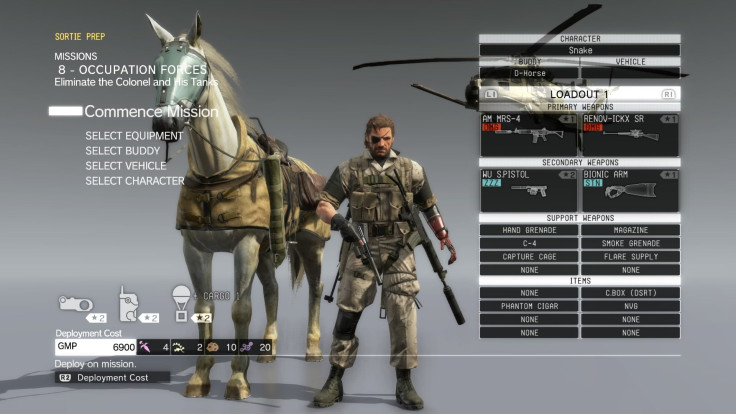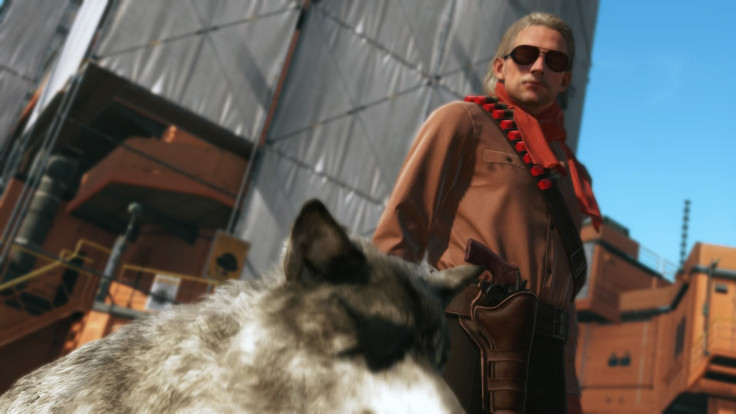Metal Gear Solid V: The Phantom Pain is one of the greatest action games to ever grace a console and easily the most enjoyable stealth-action game I’ve ever played. I just wish The Phantom Pain’s narrative bits were half as extraordinary as Metal Gear Solid V’s gameplay. Then it might actually live up to all the perfect scores we saw just before launch.
Coming off of Metal Gear Solid 4, which might as well have been sold as an interactive movie, I was hoping for a story that would grab me by the collar and refuse to let go. With so much history behind the Metal Gear franchise, not to mention some of the iconic characters who return in The Phantom Pain, Kojima Productions seemed to have all the ingredients needed to cook up something really special. But it feels like director Hideo Kojima tried to tell one too many tales in his final Metal Gear release.
Set nine years after Metal Gear Solid V: Ground Zeroes, The Phantom Pain sees players step back into the boots of Big Boss; the legendary mercenary at the center of the Metal Gear franchise. Eventually, players have the option to send other characters out in place of Venom Snake, Boss’ nom de guerre for The Phantom Pain, each of whom have their own strengths and weaknesses. Another big change for MGSV is the area of operations. Snake won’t be returning to Cuba in Metal Gear Solid V. Missions in The Phantom Pain are split between two regions, Africa and the Middle East, with the occasional trip back to Mother Base thrown into the mix for good measure.
Over time, players will build up an unbelievable arsenal of firearms, thrown weapons, spy tools and cardboard boxes. As you recruit new personnel to work at Mother Base, and expand the Diamond Dogs’ base of operations, the research and development unit will come up with new items and enhancements to make your time in the field a bit easier. Everything from Buddy costumes to helicopter parts can be developed by your team if you have the necessary money/materials. Some of which are so powerful they’ll limit your potential score if/when used during story missions.

Story missions are presented like individual episodes of a television show, with credit sequences at the front/back end of each. Each is preceded by a set-up screen, where players can choose the equipment, partner and vehicle (if desired) that Snake will bring along for the mission. And if you forget something, you can usually radio for a buddy/equipment/supply drop from Mother Base. Generally you’ll have somewhere between three and five objectives to complete, along with a few optional tasks, and your handling of the mission will determine just how easy/difficult it is to escape the hot zone afterward.
Side-ops offer a bit more flexibility than their story-focused counterparts. Optional missions in Metal Gear Solid V: The Phantom Pain can be tackled as you encounter them in the world or completed one-by-one. The latter is generally preferred, since helicopters can be used to shepherd the player from one area to the next. New jobs are unlocked in a semi-linear fashion, as players complete story/side missions from their ledger, and exploration will occasionally yield a job that hasn’t been assigned yet.
On paper, it sounds like damn near any other open-world game from the last couple of years, right?
What sets Metal Gear Solid V: The Phantom Pain apart from its competition is its handling of the battlefield. Which I suppose is appropriate, given how frequently the Metal Gear franchise has been known to devolve into monologues about the battlefield, the nature of warfare and the other pseudo-philosophical diatribes Kojima has packed into series over the years.
Outside of Mother Base, players are given a degree of freedom we’ve never experienced from the Metal Gear franchise. Story missions usually have a declared area of operations, which can’t be abandoned without losing mission progress, but your AO typically offers plenty of room for players to move around and make Snake's enemies lose sight of him Most importantly, there are an abundance of hidden and sight-obscuring trails spread throughout the world.
Missions have an abundance of potential solutions, depending on how patient you’re willing to be, and opposition forces even begin to adapt their battlefield strategies to respond to players’ actions. Waiting until nightfall to complete missions will eventually lead enemies to wear night-vision goggles when out on patrol. Kill too many enemy fighters and they’ll begin wearing body armor. Become over-reliant on headshots and you’ll be up a metaphorical creek when enemy soldiers start wearing helmets. Even the Fulton system isn’t foolproof.
Thankfully, combat in Metal Gear Solid V is like the world’s deadliest game of Rock, Paper, Scissors. Body armor won’t save your foes from melee takedowns. Wearing night-vision goggles means the enemy(s) in question can’t put on a helmet. And I’ve yet to encounter a vehicle in The Phantom Pain that could take more than a couple shots from a rocket launcher. Those who learn how to use each of Snake’s gadgets, and the situations in which they excel, will find the most success during their time with Metal Gear Solid V.

As outstanding as Metal Gear Solid V: The Phantom Pain has proven to be, the game is not without its flaws. The game’s environments can, at times, be as big a detriment to MGSV as they are a boon. The cliffs and rocky outcroppings of Afghanistan, in particular, provide a freedom unlike anything we’ve ever seen from Metal Gear up to this point. But those set pieces and environmental props are less-enjoyable when it comes time to escape the opposition and it’s not clear which can/can’t be climbed with the press of a button. The game’s lack of formal introduction for the crack-climbing mechanic, which is required to complete at least one Side Op, is also baffling.
And don’t even get me started on Quiet.
Remember when Kojima said we’d be “ashamed” of questioning his costume choices? The only thing I’m ashamed of is assuming we’d get anything different from a man who’s made ogling women a consistent part of the Metal Gear franchise. Quiet could easily have been, and might still be, one of the greatest characters in the series. She’s certainly one of the most interesting. But it’d be nice if I didn’t have to explain overly-sexual stretching, purposeless shower scenes and/or any number of other embarrassing scenes involve Quiet whenever my girlfriend is in the room. The fact that normal clothing is one of the last unlockable items for the sniper, not to mention one of the most expensive individual purchases in MGSV, really says everything about Quiet’s intended purpose in the game.
There’s also the simple fact that The Phantom Pain’s story isn’t finished. And we’re not talking about a “held back for DLC” situation, either. According to footage from the Collector’s Edition bonus disc, Metal Gear Solid V: The Phantom Pain was going to feature at least one more mission than the game shipped with. It’s not clear why it was ultimately excluded, whether Konami was unwilling to wait for the devs to finish what would have been the game’s final mission or if the dev team decided its plans for the sortie weren’t up-to-par. Regardless, without spoiling anything, I will say the mission’s absence is palpable.
Metal Gear Solid V: The Phantom Pain redefines open-world action games, offering a blend of stealth and Hollywood blockbuster explosions so seamless it can make the game difficult to walk away from. When you’re tired of sneaking, Snake has an arsenal of grenade/rocket launchers, explosives and other means of reducing enemy fortifications to a fiery pile of rubble. If that’s somehow not enough, you can always call for missile bombardment or a cover fire from your helicopter. And the game’s sprawling open-world environments give players unprecedented freedom to decide how they’ll accomplish a given task; regardless of whether they’re going in loud or quiet.
Just as importantly, Kojima Productions’ well-known attention to detail remains evident throughout Metal Gear Solid V: The Phantom Pain. Players have already found that over-playing music cassettes will eventually lead them to snap, as so many of us learned the hard way in the 80’s and 90’s, forcing players to recover another copy of your favorite song from the MGSV soundtrack. A variety of posters and camo patterns, not to mention newfound durability, make Snake’s cardboard box the most-hilariously viable tool in recent memory. And I can’t think of another game that let me use the recording of a soldier’s bowel movement to keep soldiers from searching the portable toilet where the protagonist is hiding.
The game’s focus on realism can certainly go off the rails, even when ignoring the ridiculousness/hilarity of the Fulton system. But even when things fall apart, Metal Gear Solid V: The Phantom Pain manages to be one of the most engaging games we’ve seen all year. With a few exceptions, MGSV doesn’t bombard the player with fail states or continue screens; instead giving players so many options for dealing with the opposition that even the direst situation still feels surmountable.
Completionists should know the entire game doesn’t offer this level of freedom. Many of the game’s later missions force increasingly stealthy approaches, with some outright failing you for being spotted. And I was disappointed to see the MGSV dev team recycle some of the game’s least-interesting missions to extend the Phantom Pain campaign. It’s not as egregious as The Order: 1886, and a need to avoid spoilers prevents me from going into much depth. But the missions in question stamp out every aspect of the Metal Gear Solid V experience that sets the game apart from its competition.
From a gameplay perspective, Metal Gear Solid V: The Phantom Pain is unquestionably one of the best video games I’ve ever played. Its freedom of choice on the battlefield is unparalleled. The depths of its combat mechanics are truly impressive. And the game’s attention to detail is both astounding and absurd. But the narrative aspects of Metal Gear Solid V: The Phantom Pain are a major letdown. For starters, there’s not enough of it. There are lengthy portions, both early and late in the game, when cutscenes become a bit scarce for my tastes. And the constant influx of plot-related cassette tapes being passed along to the player weren’t enough to keep me hooked. I’m a bigger fan of the game’s ending than many other players have been. Just not always fond of the path players must travel to see it.
Narrative complaints aside, Metal Gear Solid V: The Phantom Pain is pretty damn close to being the perfect send-off for the Metal Gear franchise. Even when I storm away from the game in anger, which I’ll admit has happened a couple of times, it’s only a few minutes before I’m ready to hop back into a helicopter and send Snake out to complete a few more Side Ops. And I’m more than 70 hours in.
Metal Gear Solid V: The Phantom Pain is one of those releases the gaming community will be using as a benchmark for years to come. I just hope there’s more story hidden somewhere in The Phantom Pain, or being delivered via DLC, to give the Metal Gear series the victory lap it deserves.


















